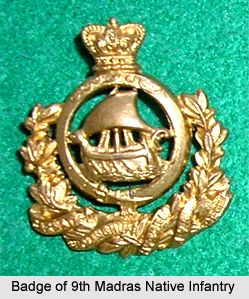 The 9th Madras Native Infantry was primarily an infantry battalion of the British East India Company, which remained in service from the year 1759 to 1922. It was a part of the Madras Native Infantry under the Army of the Madras province, before the commencement of the Great Revolt of 1857. The Madras Army was the armed forces of Madras Presidency and was amongst the 3 main Presidency Armies in British India. Later it became a part of the United British Indian Army. The army unit was also incorporated as a part of the Madras Command. The 9th Madras Native Infantry was also known as the 69th Punjabis regiment and the 9th Madras Battalion.
The 9th Madras Native Infantry was primarily an infantry battalion of the British East India Company, which remained in service from the year 1759 to 1922. It was a part of the Madras Native Infantry under the Army of the Madras province, before the commencement of the Great Revolt of 1857. The Madras Army was the armed forces of Madras Presidency and was amongst the 3 main Presidency Armies in British India. Later it became a part of the United British Indian Army. The army unit was also incorporated as a part of the Madras Command. The 9th Madras Native Infantry was also known as the 69th Punjabis regiment and the 9th Madras Battalion.
History of 9th Madras Native Infantry
The 9th Madras Native Infantry was developed as the 10th Battalion Coast Sepoys in the year 1759. The army battalion was titled several times through out its existence. The regiment was designated as the 10th Carnatic Battalion in 1769 and was renamed as the 9th Madras Battalion in the year 1784. After the Kitchener reforms of the British Indian Army in 1903, the British Indian infantry regiment was finally renamed as the 69th Punjabis regiment, after the separate names of the Presidencies were eradicated.
Operations of 9th Madras Native Infantry
The battalion first served in the Carnatic Wars from the year 1746 to 1763. Later the military unit took part in the battle of Sholinghur during the Second Anglo Mysore War. The unit also participated in the Third Anglo Mysore War. During the Second Anglo Burmese War, the 69th Punjabis also participated in the occupation of Pegu. The army battalion was honoured with the Galley Badge in the year 1839, which is now the crest of the Indian Punjab Regiment.
The 9th Madras Native Infantry regiment provided military service in the Middle East on the Suez Canal during the First World War. The troops also took part in the Campaign to Gallipoli and later they were stationed in the Western Front in the year 1915.
Development of 9th Madras Native Infantry
After the end of World War I, the British Government of India renumbered and re-structured all the regiments of the British Indian army. The distinctive single battalion infantry regiments were merged together to form multi battalion regiments. As a result of these reforms, the regiment was renamed as the 2nd Battalion, 2nd Punjab Regiment in the year 1922. After the nation acquired freedom from the supremacy of the British Empire in India on 15th August 1947, the country divided into the Union of India and the Dominion of Pakistan through the Partition of India. The British Indian Army was split amongst the 2 newly independent states. The 9th Madras Native Infantry regiment was allocated to the modern Indian Army. The army unit holds the distinction of being the most senior Infantry Battalion of the Indian Army.
Designations of 9th Madras Native Infantry
The 9th Madras Native Infantry, also titled as the 10th Battalion Coast Sepoys, of the British Indian Army held a number of designations through out its existence during the restructuring of the army, like all the other regiments. These are mentioned below-
* 10th Battalion Coast Sepoys (1759)
* 10th Carnatic Battalion (1769)
* 9th Carnatic Battalion (1770)
* 9th Madras Battalion (1784)
* 1st Battalion, 9th Madras Native Infantry (1796)
* 9th Madras Native Infantry (1824)
* 9th Madras Infantry (1885)
* 69th Punjabis (1903)



















